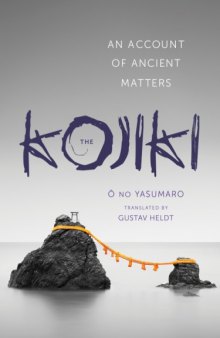 جزییات کتاب
جزییات کتاب
کوجیکی یا گزارش رویدادهای کهن نام قدیمیترین کتاب تاریخی به جا مانده در ژاپن است. این کتاب مجموعهای از اسطورهها دربارهٔ مبدأ جزیرههای ژاپن و کامیها )خدایان) است. کتاب کوجیکی کتابی است که در آن از آفرینش زمین و آسمان، خدایان متعدد، آداب و رسوم مذهبی، مرگ یا مردگان، خوبیها و شرارتها و مطالب بسیار دیگری سخن رفتهاست. در لابهلای آن اشعار بسیاری وجود دارد که به اسطورههای کهن ژاپن بازمیگردد. از سویی دیگر این کتاب، در حقیقت «شاهنامه» ژاپنیها است که به سرگذشت امپراتوران متعدد ژاپن و پهلوانان آنها میپردازد.معنی لغوی واژه کوجیکی «وقایعنگاری موضوعهای کهن» است . بسیاری از آداب و اسطورههای شینتو از کتاب کوجیکی (تالیف در سال ۷۱۲ میلادی) و کتاب نیهونشوکی یا نیهونگی (تالیف در سال ۷۲۰ میلادی) الهام میگیرند. این کتاب توسط اونو یاسومارو و به فرمان ملکه گِممهی نوشته شده است. مهمترین الهه در این کتاب الهه اماتراسو الهه خورشید است که سمبل کشور ژاپن به شمار میرود و تمامی امپراتوران ژاپنی خود را از نسل این الهه میپندارند.
کتاب کوجیکی در کنار کتاب نیهونشوکی، بزرگترین مآخذ اساطیر ژاپن و افسانههای پیش از تاریخ این سرزمین محسوب میشوند.
"The Kojiki, previously translated as "A Record of Ancient Matters," is considered to be the first literary work in the history of Japan. It is a compilation of myths, history, songs, legends, genealogies, and other disparate works from which written history and literature were later created. The Kojiki tells of the origins of the four home islands of Japan central to the inspiration behind Shinto practices. The work moves in loosely historical progression starting with the creation of Japan in the age of the gods and the descent to earth of the ancestor of the imperial family through the reign of the legendary first sovereign, Emperor Jinmu, and successive rulers up to the reign of the 33rd sovereign, Empress Suiko (who reigned from 592-618). The creation myth describes the origin of Japan through a musuhi or spontaneous power through which the gods came into existence. After seven generations of gods are created by this force the last generation, male and female gods, called Ianagi and Izanami, create the islands of Japan. The two then give birth to the gods of various natural phenomena, including gods of the sea and rivers, of the mountains and plains, of the wind and, finally, of fire, who causes the death of the goddess Izanami. The male deity Izanagi then gives birth himself to the central figure in the Kojiki mythology, the Sun Goddess Amaterasu. Her descendant, the god Ninigi, comes down from heaven to earth and becomes the ancestor of the Yamato emperors"-- Read more... Abstract: "The Kojiki, previously translated as "A Record of Ancient Matters," is considered to be the first literary work in the history of Japan. It is a compilation of myths, history, songs, legends, genealogies, and other disparate works from which written history and literature were later created. The Kojiki tells of the origins of the four home islands of Japan central to the inspiration behind Shinto practices. The work moves in loosely historical progression starting with the creation of Japan in the age of the gods and the descent to earth of the ancestor of the imperial family through the reign of the legendary first sovereign, Emperor Jinmu, and successive rulers up to the reign of the 33rd sovereign, Empress Suiko (who reigned from 592-618). The creation myth describes the origin of Japan through a musuhi or spontaneous power through which the gods came into existence. After seven generations of gods are created by this force the last generation, male and female gods, called Ianagi and Izanami, create the islands of Japan. The two then give birth to the gods of various natural phenomena, including gods of the sea and rivers, of the mountains and plains, of the wind and, finally, of fire, who causes the death of the goddess Izanami. The male deity Izanagi then gives birth himself to the central figure in the Kojiki mythology, the Sun Goddess Amaterasu. Her descendant, the god Ninigi, comes down from heaven to earth and becomes the ancestor of the Yamato emperors"
 درباره نویسنده
درباره نویسنده

آوه (آبه) شهرکی کهن نزدیک ساوه بوده و اکنون شهری است از بخش مرکزی که در جنوب شهرستان ساوه در استان مرکزی ایران قرار دارد.
 دانلود کتاب
دانلود کتاب
 جزییات کتاب
جزییات کتاب
 درباره نویسنده
درباره نویسنده
 آوه (آبه) شهرکی کهن نزدیک ساوه بوده و اکنون شهری است از بخش مرکزی که در جنوب شهرستان ساوه در استان مرکزی ایران قرار دارد.
آوه (آبه) شهرکی کهن نزدیک ساوه بوده و اکنون شهری است از بخش مرکزی که در جنوب شهرستان ساوه در استان مرکزی ایران قرار دارد. 








 این کتاب رو مطالعه کردید؟ نظر شما چیست؟
این کتاب رو مطالعه کردید؟ نظر شما چیست؟
